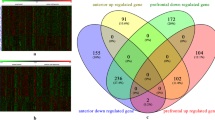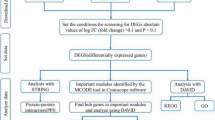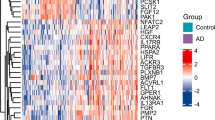Abstract
Major depressive disorder (MDD) is generally among the most prevalent psychiatric illnesses. Significant advances have occurred in comprehension of the MDD biology. However, it is still essential to recognize new biomarkers for potential targeted treatment of patients with MDD. The present work deals with in-depth comparative computational analyses to obtain new insights, such as gene ontology and pathway enrichment analyses and weighted gene co-expression network analysis (WGCNA) through gene expression dataset. The expression of selected hub-genes was validated in MDD patients using quantitative real-time PCR (RT-qPCR). We found that MDD progression includes the turquoise module genes (p-value = 1e-18, r = 0.97). According to gene enrichment analysis, the cytokine-mediated signaling pathway mostly involves genes in this module. By selection of four candidate hub-genes (IL6, NRG1, TNF, and BDNF), RT-qPCR validation was performed. A significant NRG1 downregulation was revealed by the RT-qPCR outcomes in MDD. In MDD patients, TNF and IL6 expression were considerably higher, and no considerable differences were found in the BDNF expression. Ultimately, based on ROC analyses, IL6, NRG1, and TNF had a higher MDD diagnostic performance. Therefore, our study presents information on the intricate association between MDD development and cytokine-mediated signaling, thus providing new rationales to develop new therapeutic approaches.











Similar content being viewed by others
Data Availability
The data will be available from the authors on reasonable request.
References
American Psychiatric Association (2013) Diagnostic and statistical manual of mental disorders: DSM-5, 5th edn. American Psychiatric Publishing, Washington, D.C.
Andersen CL, Jensen JL, Ørntoft TF (2004) Normalization of real-time quantitative reverse transcription-PCR data: a model-based variance estimation approach to identify genes suited for normalization, applied to bladder and colon cancer data sets. Can Res 64(15):5245–5250
Arnsten AF (2009) Stress signalling pathways that impair prefrontal cortex structure and function. Nat Rev Neurosci 10(6):410–422
Aydemir O, Deveci A, Taneli F (2005) The effect of chronic antidepressant treatment on serum brain-derived neurotrophic factor levels in depressed patients: a preliminary study. Prog Neuropsychopharmacol Biol Psychiatry 29(2):261–265
Banerjee S et al (2022) Neuregulin-1 signaling regulates cytokines and chemokines expression and secretion in granulosa cell. J Ovarian Res 15(1):86
Besedovsky HO, del Rey A (1996) Immune-neuro-endocrine interactions: facts and hypotheses. Endocr Rev 17(1):64–102
Biomarkers and surrogate endpoints (2001) preferred definitions and conceptual framework. Clin Pharmacol Ther 69(3):89–95
Castrén E, Monteggia LM (2021) Brain-Derived neurotrophic factor signaling in depression and antidepressant action. Biol Psychiatry 90(2):128–136
Cattaneo A et al (2013) Candidate genes expression profile associated with antidepressants response in the GENDEP study: differentiating between baseline ‘predictors’ and longitudinal ‘targets.’ Neuropsychopharmacology 38(3):377–385
Chacón-Fernández P et al (2016) Brain-derived neurotrophic factor in megakaryocytes. J Biol Chem 291(19):9872–9881
Chen EY et al (2013) Enrichr: interactive and collaborative HTML5 gene list enrichment analysis tool. BMC Bioinformatics 14(1):1–14
Clarke DJ et al (2017) Endocannabinoid dysregulation in cognitive and stress-related brain regions in the Nrg1 mouse model of schizophrenia. Prog Neuropsychopharmacol Biol Psychiatry 72:9–15
Corbett BF et al (2019) Sphingosine-1-phosphate receptor 3 in the medial prefrontal cortex promotes stress resilience by reducing inflammatory processes. Nat Commun 10(1):3146
Derakhshani A et al (2022) Identification of common and distinct pathways in inflammatory bowel disease and colorectal cancer: a hypothesis based on weighted gene co-expression network analysis. Front Genet 13
Diniz BS et al (2014) Reduced cerebrospinal fluid levels of brain-derived neurotrophic factor is associated with cognitive impairment in late-life major depression. J Gerontol B Psychol Sci Soc Sci 69(6):845–851
Dowlati Y et al (2010) A meta-analysis of cytokines in major depression. Biol Psychiat 67(5):446–457
Du Y et al (2019) Genome-Wide, Integrative analysis implicates exosome-derived microRNA dysregulation in schizophrenia. Schizophr Bull 45(6):1257–1266
Du Y et al (2021) Exosome transplantation from patients with schizophrenia causes schizophrenia-relevant behaviors in mice: an integrative multi-omics data analysis. Schizophr Bull 47(5):1288–1299
Felger JC, Lotrich FE (2013) Inflammatory cytokines in depression: neurobiological mechanisms and therapeutic implications. Neuroscience 246:199–229
Fries GR, Quevedo J (2018) Exosomal microRNAs as potential biomarkers in neuropsychiatric disorders. Methods Mol Biol 1733:79–85
Fujimura H et al (2002) Brain-derived neurotrophic factor is stored in human platelets and released by agonist stimulation. Thromb Haemost 87(4):728–734
Geissler A, Ryzhov S, Sawyer DB (2020) Neuregulins: protective and reparative growth factors in multiple forms of cardiovascular disease. Clin Sci (london) 134(19):2623–2643
Gervasoni N et al (2005) Partial normalization of serum brain-derived neurotrophic factor in remitted patients after a major depressive episode. Neuropsychobiology 51(4):234–238
Ghassemzadeh H et al (2005) Psychometric properties of a Persian-language version of the Beck depression inventory–second edition: BDI-II-PERSIAN. Depress Anxiety 21(4):185–192
Gold PW, Machado-Vieira R, Pavlatou MG (2015) Clinical and biochemical manifestations of depression: relation to the neurobiology of stress. Neural Plast 2015:581976
Guo W-P et al (2006) Neuroprotective effects of neuregulin-1 in rat models of focal cerebral ischemia. Brain Res 1087(1):180–185
Hacimusalar Y, Eşel E (2018) Suggested biomarkers for major depressive disorder. Noro Psikiyatr Ars 55(3):280–290
Han QQ, Yu J (2014) Inflammation: a mechanism of depression? Neurosci Bull 30(3):515–523
Hannestad J, DellaGioia N, Bloch M (2011) The effect of antidepressant medication treatment on serum levels of inflammatory cytokines: a meta-analysis. Neuropsychopharmacology 36(12):2452–2459
Haroon E, Raison CL, Miller AH (2012) Psychoneuroimmunology meets neuropsychopharmacology: translational implications of the impact of inflammation on behavior. Neuropsychopharmacology 37(1):137–162
Hennings JM et al (2019) Polymorphisms in the BDNF and BDNFOS genes are associated with hypothalamus-pituitary axis regulation in major depression. Prog Neuropsychopharmacol Biol Psychiatry 95:109686
Hestad KA et al (2003) Raised plasma levels of tumor necrosis factor α in patients with depression: normalization during electroconvulsive therapy. J ECT 19(4):183–188
Holtman IR et al (2015) Induction of a common microglia gene expression signature by aging and neurodegenerative conditions: a co-expression meta-analysis. Acta Neuropathol Commun 3:1–18
Iosif RE et al (2006) Tumor necrosis factor receptor 1 is a negative regulator of progenitor proliferation in adult hippocampal neurogenesis. J Neurosci 26(38):9703–9712
Kahl KG et al (2006) Cortisol, the cortisol-dehydroepiandrosterone ratio, and pro-inflammatory cytokines in patients with current major depressive disorder comorbid with borderline personality disorder. Biol Psychiat 59(7):667–671
Kaneko N et al (2006) Suppression of cell proliferation by interferon-alpha through interleukin-1 production in adult rat dentate gyrus. Neuropsychopharmacology 31(12):2619–2626
Karege F et al (2005) Low brain-derived neurotrophic factor (BDNF) levels in serum of depressed patients probably results from lowered platelet BDNF release unrelated to platelet reactivity. Biol Psychiatry 57(9):1068–1072
Kim YK, Ham BJ, Han KM (2019) Interactive effects of genetic polymorphisms and childhood adversity on brain morphologic changes in depression. Prog Neuropsychopharmacol Biol Psychiatry 91:4–13
Koo JW et al (2010) Nuclear factor-κB is a critical mediator of stress-impaired neurogenesis and depressive behavior. Proc Natl Acad Sci 107(6):2669–2674
Krishnadas R, Cavanagh J (2012) Depression: an inflammatory illness? J Neurol Neurosurg Psychiatry 83(5):495–502
Lakhan SE, Vieira K, Hamlat E (2010) Biomarkers in psychiatry: drawbacks and potential for misuse. Int Arch Med 3:1
Langfelder P, Horvath S (2008) WGCNA: an R package for weighted correlation network analysis. BMC Bioinformatics 9(1):1–13
Lommatzsch M et al (2005) The impact of age, weight and gender on BDNF levels in human platelets and plasma. Neurobiol Aging 26(1):115–123
Maenhoudt N et al (2020) Developing organoids from ovarian cancer as experimental and preclinical models. Stem Cell Reports 14(4):717–729
Maes M, Noto C, Brietzke E (2015) Omics-based depression and inflammation research. Braz J Psychiatry 37(1):1–2
Miyata S et al (2016) Blood Transcriptomic markers in patients with late-onset major depressive disorder. PLoS ONE 11(2):e0150262
Monje ML, Toda H, Palmer TD (2003) Inflammatory blockade restores adult hippocampal neurogenesis. Science 302(5651):1760–1765
Naegelin Y et al (2018) Measuring and validating the levels of brain-derived neurotrophic factor in human serum. eNeuro 5(2).
Negrón-Oyarzo I, Aboitiz F, Fuentealba P (2016) Impaired functional connectivity in the prefrontal cortex: a mechanism for chronic stress-induced neuropsychiatric disorders. Neural plasticity
Nomiri S et al (2022) Prediction and validation of GUCA2B as the hub-gene in colorectal cancer based on co-expression network analysis: In-silico and in-vivo study. Biomed Pharmacother 147:112691
O’Brien SM et al (2007) Plasma cytokine profiles in depressed patients who fail to respond to selective serotonin reuptake inhibitor therapy. J Psychiatr Res 41(3–4):326–331
Ogawa S et al (2014) Plasma L-tryptophan concentration in major depressive disorder: new data and meta-analysis. J Clin Psychiatry 75(9):14646
Pace TW, Hu F, Miller AH (2007) Cytokine-effects on glucocorticoid receptor function: relevance to glucocorticoid resistance and the pathophysiology and treatment of major depression. Brain Behav Immun 21(1):9–19
Pariante CM (2009) Risk factors for development of depression and psychosis: glucocorticoid receptors and pituitary implications for treatment with antidepressantand glucocorticoids. Ann NY Acad Sci 1179(1):144–152
Pariante CM (2017) Why are depressed patients inflamed? A reflection on 20 years of research on depression, glucocorticoid resistance and inflammation. Eur Neuropsychopharmacol 27(6):554–559
Peng C-H et al (2008) Neuroprotection by Imipramine against lipopolysaccharide-induced apoptosis in hippocampus-derived neural stem cells mediated by activation of BDNF and the MAPK pathway. Eur Neuropsychopharmacol 18(2):128–140
Pittenger C, Duman RS (2008) Stress, depression, and neuroplasticity: a convergence of mechanisms. Neuropsychopharmacology 33(1):88–109
Polacchini A et al (2015) A method for reproducible measurements of serum BDNF: comparison of the performance of six commercial assays. Sci Rep 5:17989
Polyakova M et al (2015) BDNF as a biomarker for successful treatment of mood disorders: a systematic & quantitative meta-analysis. J Affect Disord 174:432–440
Radka SF et al (1996) Presence of brain-derived neurotrophic factor in brain and human and rat but not mouse serum detected by a sensitive and specific immunoassay. Brain Res 709(1):122–301
Richter-Levin G, Xu L (2018) How could stress lead to major depressive disorder? IBRO Rep 4:38–43
Ridder K et al (2014) Extracellular vesicle-mediated transfer of genetic information between the hematopoietic system and the brain in response to inflammation. PLoS Biol 12(6):e1001874
Ritchie ME et al (2015) limma powers differential expression analyses for RNA-sequencing and microarray studies. Nucleic Acids Res 43(7):e47
Ruiz NAL et al (2022) Inflammatory process and immune system in major depressive disorder. Int J Neuropsychopharmacol 25(1):46–53
Samsom JN, Wong AH (2015) Schizophrenia and depression co-morbidity: what we have learned from animal models. Front Psych 6:13
Schneider B, Prvulovic D (2013) Novel biomarkers in major depression. Curr Opin Psychiatry 26(1):47–53
Seifert T et al (2010) Endurance training enhances BDNF release from the human brain. Am J Physiol Regul Integr Comp Physiol 298(2):R372–R377
Serra-Millàs M (2016) Are the changes in the peripheral brain-derived neurotrophic factor levels due to platelet activation? World J Psychiatry 6(1):84–101
Shadrina M, Bondarenko EA, Slominsky PA (2018) Genetics factors in major depression disease. Front Psychiatry 9:334
Shi L, Bergson CM (2020) Neuregulin 1: an intriguing therapeutic target for neurodevelopmental disorders. Transl Psychiatry 10(1):190
Shyu WC et al (2004) Functional recovery of stroke rats induced by granulocyte colony-stimulating factor-stimulated stem cells. Circulation 110(13):1847–1854
Silver JD, Ritchie ME, Smyth GK (2009) Microarray background correction: maximum likelihood estimation for the normal-exponential convolution. Biostatistics 10(2):352–363
Simmons LJ et al (2016) Regulation of inflammatory responses by neuregulin-1 in brain ischemia and microglial cells in vitro involves the NF-kappa B pathway. J Neuroinflammation 13(1):237
Solomon W et al (2014) Neuregulin-1 attenuates mortality associated with experimental cerebral malaria. J Neuroinflammation 11:9
Strawbridge R et al (2015) Inflammation and clinical response to treatment in depression: a meta-analysis. Eur Neuropsychopharmacol 25(10):1532–1543
Tamura S et al (2011) Release reaction of brain-derived neurotrophic factor (BDNF) through PAR1 activation and its two distinct pools in human platelets. Thromb Res 128(5):e55-61
Tamura S et al (2012) BDNF, produced by a TPO-stimulated megakaryocytic cell line, regulates autocrine proliferation. Biochem Biophys Res Commun 427(3):542–546
Tan W et al (2007) Molecular cloning of a brain-specific, developmentally regulated neuregulin 1 (NRG1) isoform and identification of a functional promoter variant associated with schizophrenia. J Biol Chem 282(33):24343–24351
Tuglu C et al (2003) Increased serum tumor necrosis factor-alpha levels and treatment response in major depressive disorder. Psychopharmacology 170:429–433
Vermeulen Z et al (2017) Inhibitory actions of the NRG-1/ErbB4 pathway in macrophages during tissue fibrosis in the heart, skin, and lung. Am J Physiol Heart Circ Physiol 313(5):H934-h945
Wang Z, Meng Z, Chen C (2022) Screening of potential biomarkers in peripheral blood of patients with depression based on weighted gene co-expression network analysis and machine learning algorithms. Front Psychiatry 13:1009911
Wei ZX et al (2020) Exosomes from patients with major depression cause depressive-like behaviors in mice with involvement of miR-139-5p-regulated neurogenesis. Neuropsychopharmacology 45(6):1050–1058
Wei J et al (2023) Identification of AGXT2, SHMT1, and ACO2 as important biomarkers of acute kidney injury by WGCNA. PLoS ONE 18(2):e0281439
Xu Z et al (2005) Neuroprotection by neuregulin-1 following focal stroke is associated with the attenuation of ischemia-induced pro-inflammatory and stress gene expression. Neurobiol Dis 19(3):461–470
Xu Z et al (2006) Extended therapeutic window and functional recovery after intraarterial administration of neuregulin-1 after focal ischemic stroke. J Cereb Blood Flow Metab 26(4):527–535
Xu J et al (2020) Nedd4l downregulation of NRG1 in the mPFC induces depression-like behaviour in CSDS mice. Transl Psychiatry 10(1):249
Yamamoto H, Gurney ME (1990) Human platelets contain brain-derived neurotrophic factor. J Neurosci 10(11):3469–3478
Yeung KY, Ruzzo WL (2001) Principal component analysis for clustering gene expression data. Bioinformatics 17(9):763–774
Yirmiya R, Goshen I (2011) Immune modulation of learning, memory, neural plasticity and neurogenesis. Brain Behav Immun 25(2):181–213
Young JJ, Bruno D, Pomara N (2014) A review of the relationship between proinflammatory cytokines and major depressive disorder. J Affect Disord 169:15–20
Yuan Q et al (2021) WGCNA identification of TLR7 as a novel diagnostic biomarker, progression and prognostic indicator, and immunotherapeutic target for stomach adenocarcinoma. Cancer Med 10(12):4004–4016
Zhang Z et al (2017) BACE1-dependent neuregulin-1 signaling: an implication for schizophrenia. Front Mol Neurosci 10:302
Zhang B, Horvath S (2005) A general framework for weighted gene co-expression network analysis. Stat Appl Genet Mol Biol 4:Article17
Zhu Y, Yang X, Zu Y(2022) Integrated analysis of WGCNA and machine learning identified diagnostic biomarkers in dilated cardiomyopathy with heart failure. Front Cell Dev Biol 10
Funding
This work was supported by Research Center for Life & Health Sciences & Biotechnology.
Author information
Authors and Affiliations
Contributions
SJ and HS conceptualized and designed the study and revised the manuscript; SAMN collected the data, evaluated and interpreted the results, and wrote the manuscript. All authors approved the current version of the manuscript.
Corresponding authors
Ethics declarations
Ethics Approval
This study was performed in line with the principles of the Declaration of Helsinki. The study protocol was approved by the ethical committee of Shahid Beheshti University of Medical Sciences (IR.SBMU.TEB.POLICE.REC.1402.056).
Consent to Participate
Informed consent was obtained from all individual participants included in the study.
Consent for Publication
Not applicable.
Competing Interests
The authors declare no competing interests.
Additional information
Publisher's Note
Springer Nature remains neutral with regard to jurisdictional claims in published maps and institutional affiliations.
Supplementary Information
Below is the link to the electronic supplementary material.
Rights and permissions
Springer Nature or its licensor (e.g. a society or other partner) holds exclusive rights to this article under a publishing agreement with the author(s) or other rightsholder(s); author self-archiving of the accepted manuscript version of this article is solely governed by the terms of such publishing agreement and applicable law.
About this article
Cite this article
Jalili, S., Shirzad, H. & Mousavi Nezhad, S.A. Prediction and Validation of Hub Genes Related to Major Depressive Disorder Based on Co-expression Network Analysis. J Mol Neurosci 74, 8 (2024). https://doi.org/10.1007/s12031-023-02172-5
Received:
Accepted:
Published:
DOI: https://doi.org/10.1007/s12031-023-02172-5




